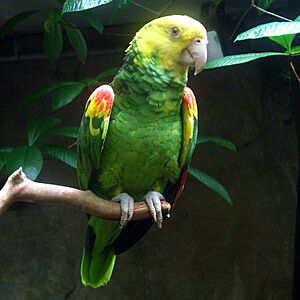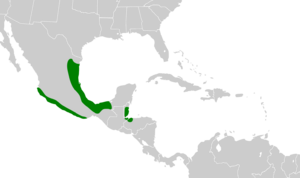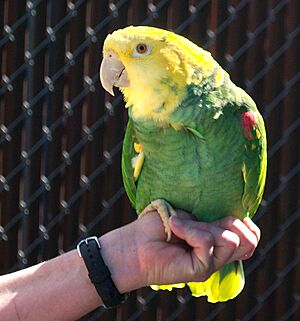Yellow-headed amazon facts for kids
Quick facts for kids Yellow-headed amazon |
|
|---|---|
 |
|
| At Vancouver Aquarium | |
| Conservation status | |
| Scientific classification | |
| Genus: |
Amazona
|
| Species: |
oratrix
|
 |
|
| Synonyms | |
|
Amazona ochrocephala oratrix |
|
The yellow-headed amazon (Amazona oratrix) is a beautiful parrot also known as the yellow-headed parrot. It lives in Mexico and northern Central America. This parrot is an endangered bird, which means it is at high risk of disappearing forever.
These parrots are about 38 to 43 centimeters (15 to 17 inches) long. They are stocky, green birds with a bright yellow head and a short tail. Yellow-headed amazons like to live in mangrove forests or other forests close to rivers and water. They are popular pets because they are excellent at "talking" and mimicking sounds. Sadly, many are illegally caught from the wild to be sold as pets. This has caused their numbers to drop very low. About half of the birds caught in the wild do not survive the process.
Contents
Understanding the Yellow-Headed Amazon's Family
The yellow-headed amazon is part of a group of parrots that look very similar. This group includes the yellow-naped amazon. Scientists sometimes find it tricky to decide if these birds are all one species or different ones. They look at how much yellow is on their feathers, and the color of their legs and beaks.
One interesting thing is that the yellow-headed amazon is sometimes called the "double yellow-headed" parrot. This is because it has yellow feathers on both the back of its neck (nape) and the top of its head (crown). Other similar parrots might only have yellow in one of these places.
What Does a Yellow-Headed Amazon Look Like?
Yellow-headed amazons are usually 38 to 43 centimeters (15 to 17 inches) long. They have a strong body, rounded wings, and a square-shaped tail. Their body is a bright green color.
Their most noticeable feature is the yellow on their head. They also have dark, scallop-shaped markings on their neck. You might see a splash of red on the bend of their wing and yellow feathers on their upper legs. Their flight feathers, which are the long feathers used for flying, are dark, almost black or purple. They also have a red patch on some of these feathers. The base of their tail has a red patch too, but it's often hidden. The tips of their outer tail feathers are yellowish.
Their beak is usually a gray color. Young birds from Belize might have a darker beak. The skin around their eyes is whitish in Mexican birds and grayish in others. The amount of yellow on their head can be different depending on where they come from. For example, adults from the Tres Marías Islands have yellow on their whole head and upper chest. Birds from Belize might only have yellow on their crown. Young birds have less yellow than adults. It takes them about 2 to 4 years to get their full adult colors.
Some yellow-headed amazons are specially bred to have even more yellow feathers. These are sometimes called "Magna" parrots. They are very popular as pets and can be quite expensive.
Wild yellow-headed amazons make low-pitched, sometimes human-like screams. They can also fly silently, which is different from many other parrots. Their calls can sound like a rolled "kyaa-aa-aaah" or a deep, rolled "ahrrrr." Young birds make a "clucking" sound when they are hungry.
Where Do Yellow-Headed Amazons Live?
These parrots live in forests near rivers and in areas with scattered trees. They also live in evergreen forests in Belize and in mangrove forests in Guatemala. You might see them alone, in pairs, or sometimes in small or even large groups.
Their natural home used to cover a much larger area in Mexico and parts of Central America. However, their numbers have dropped dramatically. From the mid-1970s to 1994, their population decreased by 90%. From 1994 to 2004, it dropped by another 68%. This huge decline is mainly because people catch them to sell as pets and because their forest homes are being destroyed.
You can also find small groups of yellow-headed amazons in places where they were not originally from. For example, there's a group of over 50 birds in Stuttgart, Germany. Smaller groups can be found in coastal areas of San Diego, California, and other parts of Southern California. They have also been seen breeding in Puerto Rico.
Protecting the Yellow-Headed Amazon
The yellow-headed amazon is listed as an endangered species by the IUCN (International Union for Conservation of Nature). This means they are at a very high risk of becoming extinct in the wild. They are also protected under CITES Appendix I. This international agreement controls the trade of endangered animals, including those bred in captivity, to help protect them.
The demand for yellow-headed amazons as pets continues to be a big problem. Illegal poaching, which is catching animals from the wild without permission, has pushed them close to extinction. Their wild population has gone from 70,000 birds to only about 7,000 in just the last two decades. It is estimated that 40-60% of poached yellow-headed amazons die before they are even sold.
Sometimes, dishonest bird sellers might try to trick people by bleaching or dyeing the feathers of other parrot species to make them look like the more expensive yellow-headed amazons. This cruel practice is often deadly for the birds.
There are special breeding programs, like one near Canberra in Australia, that help to raise these parrots in a controlled environment. These programs aim to provide birds for research and as pets, which can help reduce the pressure on wild populations.
Yellow-Headed Amazons as Pets
Yellow-headed amazons are very popular pets. They have been kept by people for hundreds of years because they are known for their amazing ability to "talk" and mimic sounds. Only yellow-headed amazons that have been bred in captivity should be owned as pets.
These parrots are often considered some of the best talkers, sometimes even matching the famous grey parrot. They seem to love singing and learning songs, and they have a naturally strong, loud voice.
Unlike some other parrots, yellow-headed amazons rarely pull out their own feathers when they are nervous. However, male yellow-headed amazons can sometimes become aggressive during breeding season due to their hormones. They are known for bonding very strongly with one person in a household. They become very loyal to that person. It can be challenging, but it is possible to help them get used to other family members by making sure everyone gives the bird equal attention.
Captive yellow-headed amazons are known for having a big appetite and enjoying many different kinds of food. Owners need to be careful because these parrots can easily become overweight or not get enough nutrients if they don't get enough exercise or are given too many treats. The World Parrot Trust suggests that these parrots should be kept in a cage that is at least 3 meters (about 10 feet) long and kept at a temperature no lower than 10°C (50°F).






